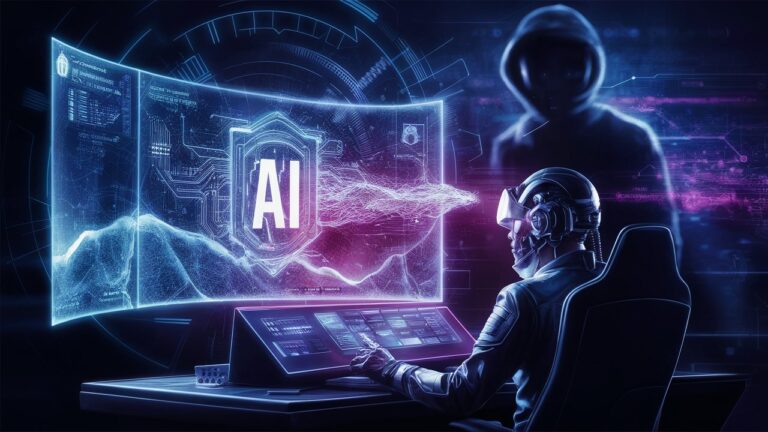Introduction
The digital landscape is in the midst of a profound and irreversible transformation, driven primarily by the relentless advancement of Artificial Intelligence. In the realm of cybersecurity, this transformation feels particularly acute, creating a dynamic and high-stakes arms race between defenders and attackers. For years, cybersecurity has been a game of cat and mouse, with human experts building walls and threat actors finding new ways to scale them. However, the introduction of AI has fundamentally altered the rules of engagement, accelerating every aspect of the conflict to near-instantaneous speeds. This is not merely an incremental change; it is a paradigm shift that is redefining the very nature of digital threats and the defenses we mount against them. This article delves deep into the intricate dance between AI-powered security solutions and AI-fuelled cyber threats, exploring the key areas where this technology is proving to be both our greatest ally and our most formidable adversary. We will navigate the complex terrain of automated threat detection, predictive analytics, and the emergence of sophisticated AI-driven social engineering, providing a comprehensive overview of what it means to secure an enterprise in the age of intelligent machines.
AI-Powered Threat Detection and Response
One of the most significant contributions of AI to the cybersecurity domain lies in its unparalleled capacity for AI-Powered Threat Detection and Response. Traditional security systems often rely on signature-based methods, which are inherently reactive; they can only identify threats that have been seen before and for which a digital fingerprint, or signature, has been created. This approach is woefully inadequate against zero-day exploits and novel, polymorphic malware. AI, particularly through machine learning models, revolutionizes this process by learning the baseline of “normal” behavior for a network, user, or application. By analyzing vast datasets of network traffic, user logins, file access patterns, and process execution in real-time, these models can identify subtle, anomalous activities that would be invisible to the human eye. When a deviation from the norm is detected—such as a user accessing sensitive data at an unusual hour from a foreign location, or a piece of software making unexpected network connections—the system can flag it instantly. Furthermore, the response is becoming increasingly automated. Security Orchestration, Automation, and Response (SOAR) platforms, infused with AI, can not only identify a threat but also automatically initiate containment protocols, such as isolating an infected endpoint from the network, blocking a malicious IP address, or revoking user credentials, all within milliseconds, dramatically shrinking the critical window of opportunity for an attacker.
Predictive Analytics in Proactive Cyber Defense
Moving beyond mere reaction, AI is enabling a more forward-looking security posture through the power of Predictive Analytics in Proactive Cyber Defense. This concept involves using AI to sift through massive amounts of data, including global threat intelligence feeds, dark web chatter, and historical attack data, to forecast future vulnerabilities and potential attack vectors before they are exploited. Imagine a system that can analyze trends in emerging malware families and predict which software vulnerabilities are most likely to be targeted by criminal groups in the coming weeks. This allows security teams to transition from a frantic, patch-and-pray cycle to a strategic, prioritized remediation process. They can proactively apply patches to the most critical systems first, strengthen defenses around the assets most likely to be attacked, and even run simulated “what-if” scenarios to test their resilience. This shift from a reactive to a predictive stance is arguably one of the most powerful advantages offered by AI, transforming cybersecurity from a constant firefight into a more managed, intelligence-driven operation. It allows organizations to allocate their often-limited resources more effectively, focusing human expertise on strategic planning and complex analysis rather than being overwhelmed by an endless stream of alerts.
The Rise of AI-Generated Cyber Threats
However, the same capabilities that empower defenders are also being weaponized by malicious actors, leading to The Rise of AI-Generated Cyber Threats. Cybercriminals are now leveraging AI to create more sophisticated, scalable, and evasive attacks. For instance, AI can be used to generate highly convincing phishing emails at an industrial scale. Gone are the days of poorly written messages with obvious grammatical errors; AI-powered natural language generation can create perfectly crafted, personalized emails that mimic the writing style of a colleague or executive, making them incredibly difficult to distinguish from legitimate communication. This is often referred to as “spear-phishing at scale.” Furthermore, AI can be used to develop advanced malware that can autonomously adapt to its environment. Polymorphic and metamorphic malware, powered by AI, can constantly change its code to evade signature-based detection without altering its core malicious function. AI can also be used to power automated password cracking tools that learn from previous attempts and optimize their strategies, or to create deepfake audio and video for sophisticated business email compromise (BEC) schemes. This democratization of advanced attack capabilities means that even less-skilled attackers can now deploy highly effective campaigns, significantly lowering the barrier to entry for cybercrime.

Automated Security Policy Enforcement and Compliance
On the defensive side, another critical application is Automated Security Policy Enforcement and Compliance. For large enterprises, ensuring that thousands of employees and countless devices are consistently adhering to complex security policies is a monumental task. Human auditors simply cannot monitor every configuration change, every software installation, or every cloud storage setting in real-time. AI-driven systems excel at this. They can continuously monitor the entire digital estate, from on-premises servers to cloud instances, and automatically enforce policies. If an employee accidentally configures an Amazon S3 bucket to be publicly accessible, the AI system can detect the misconfiguration instantly and either alert administrators or, in more advanced setups, automatically revert the change to a secure state. This continuous compliance monitoring is invaluable for meeting the stringent requirements of regulations like GDPR, HIPAA, or PCI-DSS. It removes human error from the equation and ensures that the organization’s security posture remains robust and consistent, not just during an audit but at all times, creating a resilient and self-healing IT environment.
The Future of AI in Cybersecurity: An Enduring Arms Race
Looking ahead, it is clear that The Future of AI in Cybersecurity points toward an enduring and increasingly automated arms race. We are moving towards a landscape where AI systems will essentially do battle with other AI systems in real-time. Defensive AI will be tasked with identifying and neutralizing attacks launched by offensive AI. This will necessitate the development of even more advanced AI that can engage in “adversarial learning,” essentially learning to think like an attacker to anticipate novel assault methods. The role of the human cybersecurity professional will not diminish but will evolve. Instead of manually sifting through logs, their role will shift to that of a strategist, trainer, and overseer—curating the data used to train the AI models, interpreting the complex outputs of the system, making high-level strategic decisions, and handling the most nuanced and sophisticated threats that may still bypass automated defenses. The future belongs not to those who abandon human expertise, but to those who most effectively fuse human intuition and strategic thinking with the raw analytical power and speed of artificial intelligence.
Conclusion
The integration of Artificial Intelligence into cybersecurity is a transformative force with no off-ramp. It has irrevocably changed the game, offering powerful new shields for defenders while simultaneously forging sharper swords for attackers. The key takeaway is that AI is not a silver bullet that will solve all cybersecurity challenges; it is a powerful tool that amplifies existing capabilities on both sides of the conflict. For organizations to thrive in this new era, a proactive and adaptive strategy is non-negotiable. This means investing not only in advanced AI-powered security solutions but also in cultivating a skilled workforce capable of managing these systems and responding to the complex threats they cannot catch. Ultimately, resilience in the age of AI-driven cyber threats will depend on a balanced, intelligent, and continuous commitment to leveraging technology while fostering human expertise.
Frequently Asked Questions (FAQs)
1. Can AI completely replace human cybersecurity analysts?
No, AI is not a replacement for human analysts but a powerful force multiplier. While AI excels at processing vast amounts of data, identifying patterns, and automating repetitive tasks at high speed, it lacks human intuition, contextual understanding, and strategic creativity. Human experts are essential for overseeing AI systems, investigating complex attacks that evade automated detection, making strategic decisions, and understanding the broader business context of a threat.
2. How are hackers using AI to improve their attacks?
Cybercriminals use AI in several nefarious ways. This includes generating highly personalized and convincing phishing emails (spear-phishing at scale), creating polymorphic malware that constantly changes its code to evade detection, using AI to power password-cracking tools that learn and adapt, and creating deepfakes for sophisticated social engineering and disinformation campaigns.
3. What is “adversarial AI” in the context of cybersecurity?
Adversarial AI refers to techniques used to attack, deceive, or mislead AI and machine learning models. In cybersecurity, an attacker might use adversarial AI to subtly manipulate input data to fool a security system. For example, they could slightly alter malicious code so that it appears benign to an AI-based malware detector, effectively making the AI model’s classification system unreliable.
4. Is AI in cybersecurity only for large enterprises, or can small businesses benefit too?
While large enterprises were early adopters, the democratization of AI through cloud-based Security-as-a-Service (SaaS) models means small and medium-sized businesses (SMBs) can also benefit significantly. Many managed security service providers (MSSPs) now offer AI-powered threat detection and response services on a subscription basis, making enterprise-grade security tools accessible and affordable for businesses of all sizes.
5. What are the potential ethical concerns or risks of using AI for security?
The use of AI in cybersecurity raises important ethical questions. These include concerns about data privacy, as AI systems require access to vast amounts of potentially sensitive data to train and operate. There is also the risk of algorithmic bias, where an AI model might make flawed decisions based on biased training data, potentially leading to false positives that unfairly target certain users or network activities. Transparency and accountability in AI decision-making remain significant challenges.
